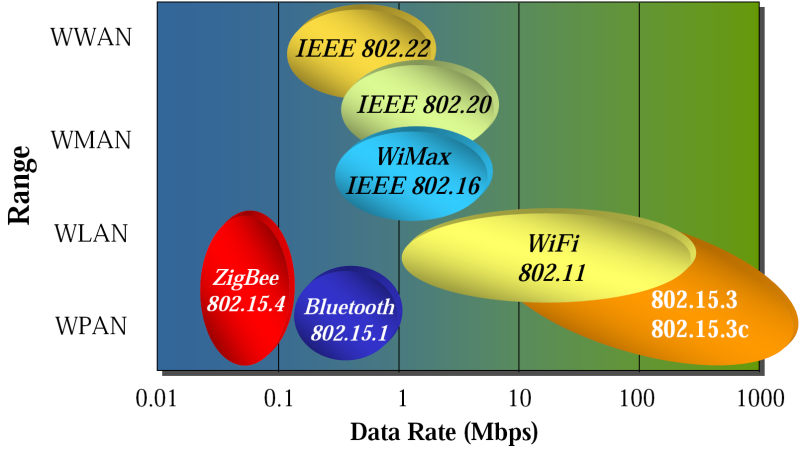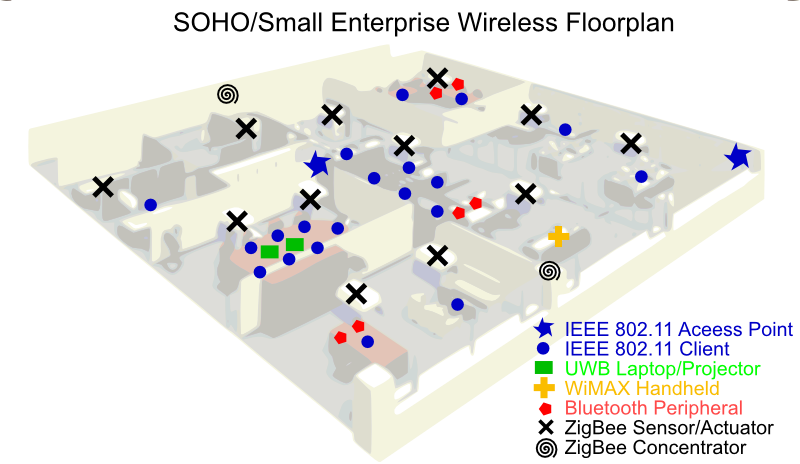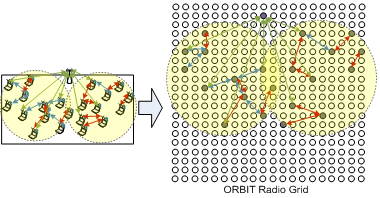Application Scenarios for Intel Coexistence Project
The methodology I propose for deriving some meaningful scenarios to evaluate potential effects of coexistence and solutions in this space is as follows:
- We determine a set of radio technologies of interest and agree on their typical operational parameters (channels, output powers/range, typical use etc.)
- We define three habitats, a subset of these radios lives in each (with a reasonable mix in terms of number, physical placement and offered traffic). Let these habitats be Home, SOHO/Small Enterprise, and Large Enterprise. The implicit assumption here is that we consider indoor type settlements. Should we think about outdoor also is a topic of discussion I will not consider, at least for now.
- For each of these habitats, we select a representative floorplan (or something similar, blueprint etc.) and place the selected radios on their “would be” locations, while thinking about the actual people and their purpose in using those technologies.
Aiming for above methodology, I first collected the following (non-exhaustive and more or less random) collection of radio technologies we might consider in a coexistence study. Feel free to add and/or correct as necessary.
| POTENTIAL RADIO TECHNOLOGIES (COEXISTENCE HABITAT) | |||||
| Radio Technology | Typical Range | Max. Output Power | Frequency Occupied | Max. Bitrate Supported | Typical Usage |
| 802.11a/b/g/n (WIFI) | 150-300 feet | 17 dBm | 2.4 GHz ISM, 5 Ghz UNII | 248 Mbits/s | WLAN, device to device ad-hoc communication, cheap long range links |
| 802.16 (WiMAX) | 3-5 miles (12 miles) | 22 dBm (handheld) 26 dBm BS | 2.300 – 2.400 GHz2.496 – 2.690 GHz3.300 – 3.800 GHz | 4 Mbits/s (70 Mbits/s) | WWAN, last mile broadband |
| Cellular (GSM,CDMA, GPRS) | 10 miles (typical) | 30dBm | 824 - 894 MHz,880 – 960 MHz1770-1880 MHz,1850-1990 MHz | 236 Kbits/s | Voice, packet data |
| UMTS (W-CDMA,CDMA 2000, 1XEVDV,1XEV-DO) | 10 miles (typical) | 30dBm | 1920 -1980 MHz2110 -2170 MHz | 14.7 Mbits/s (rev.B) | Voice, packet data |
| 802.15.1 (Bluetooth) | 150-300 feet (Class 1)15-30 feet (Class 2)3-4inch (Class 3) | 20 dBm (Class 1)4 dBm (Class 2) 0 dBm (Class 3) | 2.4 ISM | 3 Mbits/s (EDR) | WPAN, peripheral communications |
| UWB/Wireless USB | 30-100 feet | -41dBm/Hz | 3.1 – 10.6 GHz | 500 Mbits/s | WPAN, peripheral communications |
| 802.15.4 (ZIGBEE) | 33-246 feet | 3 dBm (current implementations) | 868MHz (EU), 915 Mhz (US), 2.4GHz ISM | 20-250Kbits/s | WPAN, short range device control |
| GPS | 12,000 miles | RCV Only | 1575.42 MHz1227.6 MHz | 50 bits/s | Navigation, Location Tracking |
| DVB-H | variable (2-3 mile transmitters popular) | RCV Only | 1.6-1.7GHz (US), 470-820MHz (EU) | 6.9 Mbits/s | Digital Video Broadcast, TV |
The following figure is a visual representation of the first order derivate of most of the items detailed in the table (borrowed from a ZIGBEE Alliance Presentation).
What follows is my first attempt to create the scenario for the SOHO/Small Enterprise habitat. I had an office of about ~20 active people working in a semi partitioned space, size being not much different than the ORBIT grid room. I have picked this following floorplan, which I though to be typical, and started throwing radios on to the locations I deemed appropriate. I think of this floorplan having a main conference room (a very active one, on the left, middle) and another smaller meeting room (far upper corner). Boss has a room on the right bottom corner, with frequent visitors, and the rest of the staff resides in the cubical spaces and the lab spaces on the center and rightmost side of the floorplan. Also, there are some support rooms (kitchen, copier, cabinet, mail room etc.) other than the ones I mentioned.
- I started with 802.11 network and thought that an average system/network admin would start supporting this size office (~20 people) with two access points. One of them being closer to the central area of activity: conference room. The rest is supported by the AP on the rightmost corner of the floorplan. I have distributed 20 802.11 clients depending on the seating distribution. For the traffic assumptions, I tend to refer to the recent sniffing study I did in WINLAB, and use the following simplified distribution of workload (details withdrawn here).
- TCP (97%), UDP (3%)
- WWW (75%), VoIP (3%), Background Traffic (File Transfers, Printing, etc. 22%)
- Then, I have placed a UWB enabled projector (as frequently referred to in Intel presentations
 , and a UWB enabled laptop in the conference room, assuming the meeting involves one participant streaming a video from his laptop to the projector for the rest of the audience (possibly couple of Mbits/s).
, and a UWB enabled laptop in the conference room, assuming the meeting involves one participant streaming a video from his laptop to the projector for the rest of the audience (possibly couple of Mbits/s).
- Also, I have considered three people actively using Bluetooth for their cell-phone headsets and/or to listen to music from their PCs. It is appropriate to consider these as CBR type 64Kbps or 128Kbps streams, flowing locally from one device to the other.
- Also, we have a guest sitting on the couch near the window, while he is trying to do cheap long-distance VoIP communication using the WiMAX handheld his company gave him. This traffic would be a 96Kbps UDP stream carried on 300byte frames, tolerating a max.of 5% loss with 30ms delay requirement.
- The last group of radios in this habitat belongs to the smart building infrastructure using ZIGBEE. there are sensors/actuators on each light fixture as well as a heating/AC sensor. Two ZIGBEE concentrators act as relays for the communication to the rest of the infrastructure in the building. Content of the traffic is considered to be sub-minute reading (in <50byte frames) updates and occasional reactive actuation communications not exceeding a couple of Kbits/s.
Before going any further with this approach for the other two scenarios, I would like to stop and ask for feedback on everything I have said so far.
Identify experiment scenarios
We can focus on the SOHO scenario, as most of Intel's interest may be laptop/handheld-related wireless products. As we have discussed earlier, the interference for multi-radio devices/networks are either inter-device or intra-device, and the latter problem is a better matching to this project. So I think we can clarify our near-term goal for the first stage of this project:
Study spectrum coordination methods in multi-radio devices/platforms
- Scenario: SOHO (as Ali's discussion above)
- Area: 100x100ft2 2D (actually in apartment buildings 3D scenario is also interesting)
- Node density: Randomly clustered + uniformly distributed
(1) 2x Conference room (5-10 nodes): MAX density 1-2 nodes/m2;
(2) Cubics (uniformly distributed, ~10-30 nodes): MIN density 0.5 node/m2. - Radio density: 2-4 radios/node, focusing on 2.4-2.5 GHz
- Radio type and traffic carried:
(1) (100% nodes) 1x 802.11b/g hotspot mode, Traffic: web, email, small file download, random video/audio streaming >>> Model as random TCP sessions
(2) (100% nodes) 1x 802.11b/g ad hoc point-to-point (background traffic), Traffic: Video, audio, FTP >>> Model as random UDP sessions with larger file transfers
(3) (50% nodes) 1x Bluetooth headset, Traffic: voice/audio >>> Model as 64kbps or 128kbps streaming UDP sessions
(4) (50% nodes) 1x Zigbee human-health sensor, Traffic: low duty cycle periodical data >>> Model as CBR UDP, 0.1 packets/sec, 512byes/packet
(5) Optional (20% nodes) 1x GNU radio emulating OFDM WiMax subscriber, Traffic: hybrid data and multimedia >>> Model as TDMA traffic type with full load slots (~100kbps)
(6) Optional (10% nodes) 1x UWB radios, Traffic: video >>> Model as 1Mbps CBR over UDP
(7) Optional (affect all nodes) WiMax BS signal (use signal generator), Traffic: hybrid data and multimedia >>> Model as TDMA traffic type with full load slots (~10Mbps)
- Performance criteria:
(1) Average data session Throughput: in bps
(2) Average packet or session Delay: in seconds
(3) Delay jitter for voice/audio/video: in seconds
(4) Spectrum efficiency: bits/Hz, or bits/Hz/m2
- Coordination Schemes
(1) Uncoordinated: study the performance degradation per radio link (Haris already has some results on WiFi/Bluetooth)
(2) Intra-node coordination: Time-sharing of radios equipped on one node. Is control plane helpful for intra-node coordination?
(3) Inter-node CSCC-based coordination: in ORBIT experiments, use one wired Ethernet link served as a common control plane where nodes coordinate their spectrum usage by broadcasting their radio parameters and traffic information.
- Implementation Discussions
- What is available to us which can be changed by coordination methods to reduce interference?
- What is available to us which can be changed by coordination methods to reduce interference?
Wifi: Frequency/channel, transmit power, traffic control
Bluetooth: traffic control (on/off)
Zigbee: ?
GNU radio: frequency, bandwidth, transmit power
UWB: ?
WiMax BS signal: frequency, bandwidth, transmit power, traffic density
- Other discussions ….
Let's narrow down the scenarios and techniques to be used which are appropriate for a setup using experiments on ORBIT. We can make step by step progress starting with a small setup, some measurements and reporting on per-node study and network-wide study.
Attachments (4)
- 802_space.png (244.0 KB ) - added by 18 years ago.
- 802_space.2.png (131.3 KB ) - added by 18 years ago.
- SOHO.png (164.7 KB ) - added by 18 years ago.
- orbit-setup.png (49.5 KB ) - added by 18 years ago.
Download all attachments as: .zip



